5 Different Methods Used in Casting
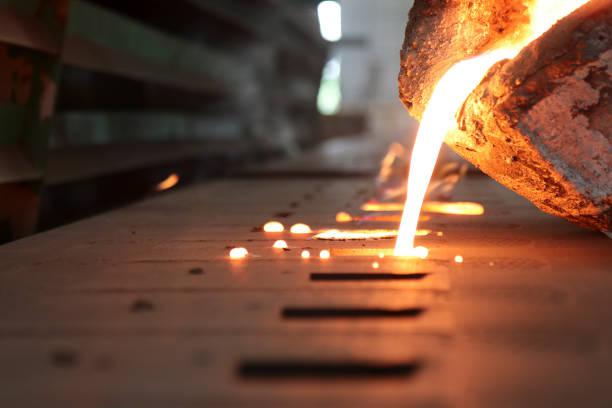
Casting involves a process where you melt materials like metal or plastic and pour them into a hollow molded shape that resembles the anticipated item.
Once the liquefied material in the mold cavities cools and hardens, it undergoes a different finishing known as the casting process to have the final item.
The process produces both solid and hollow complex shapes that form part of different pieces of equipment.
Besides being an old age technique, the shapes find a wide range of applications in modern times. For example, the shapes find usage in various automotive and aerospace industries.
Video Link: https://www.youtube.com/watch?v=ahqqmCfAA3w
Contents
Different Types of Casting Process and Methods
The technological progression has seen this ancient technique adapt highly advanced and expert casting methods.
The craft involves high forming methods and process like
- Investment casting
- Die-casting
- Sand casting
- Plaster casting
- Low-Pressure casting
Let us break down and look at each type of casting process.
1. Investment Casting
Investment casting is one of the oldest manufacturing processes where the wax or any polymer materials design molds or shapes into desired forms.
Once the melted material is ready, the shapes are then dipped and allowed to cool and harden. Furthermore, repeat the dipping process to achieve the desired thickness of the intended shape.
Allow the shape created by the wax to harden to achieve the required strength. You can then pour the melted material into the hollow shapes formed by the wax or polymer material.
Allow the cast material in the cavity to dry, and then break the molded shapes made from wax to reveal the casted shapes.
Nevertheless, follow the YouTube video link below for a detailed understanding of the process.
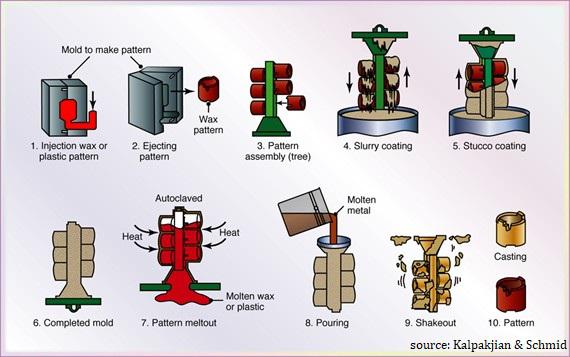
https://www.youtube.com/watch?v=lVFREX95BvU
The following diagram will guide you on the investment casting process.
2. Die Casting Process
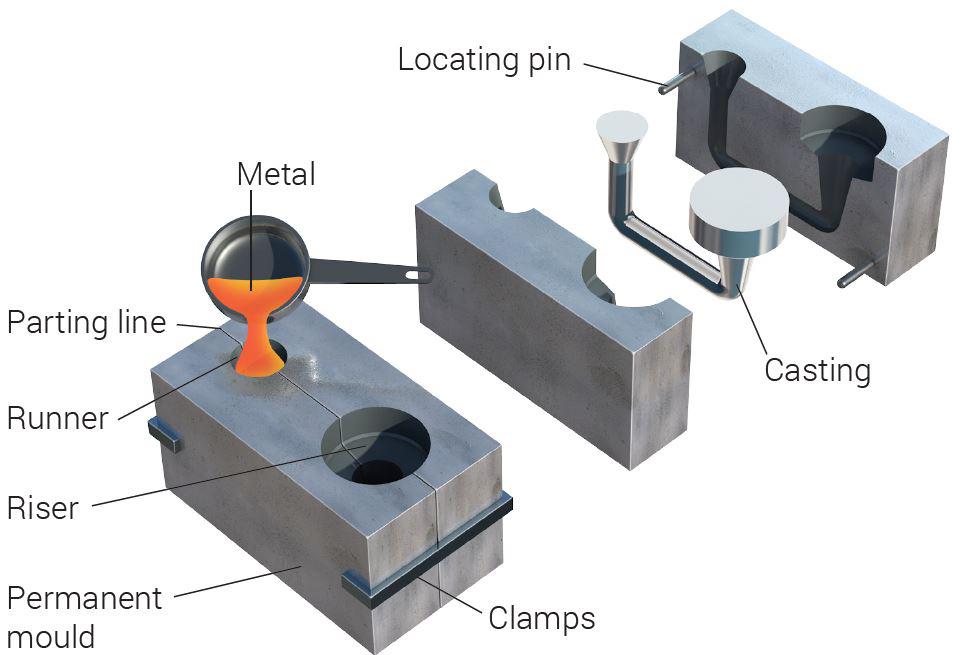
It is a casting process that involves melted material under pressure forced into a molded hollow shape.
The preparation of the mold cavity is from hard material shaped to work as the injection mold while making the casting shapes.
The melted material is allowed to cool and harden under pressure to have the intended form.
It is a highly efficient casting process that minimizes production costs and many quality and reliable cast pieces of equipment produced at once.
An excellent example of die casting equipment is the engine block with aluminum and magnesium casting shown above.
Besides, die casting produces industrial parts for the automotive industry, electronics industry, and medical instruments.
For you to understand better, follow the YouTube link below.
Moreover, the following diagram shows what the die casting process is all about
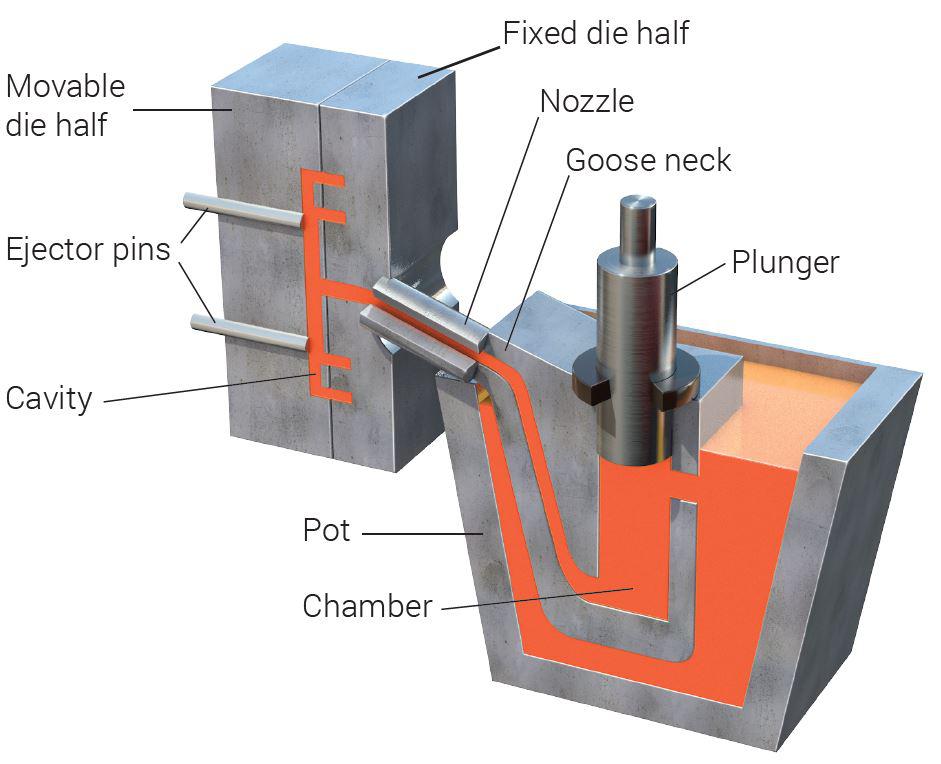
3.Sand Casting Process
Sand Casting is a process where sand is the molding material.
Therefore, the prospect part’s design or shape comes from the sand molds when the melted material is poured into the sand cavity shapes.
The melted material in the hollow mold is then allowed to cool and solidify before removing the pattern formed by sand.
This casting process is used to produce highly complex items that require detailed inner carves. Moreover, it’s a process that best suits the production of both ferrous and non-ferrous metal shapes with large dimensions.
It is a low-cost process used to produce expensive casting equipment like cylinder heads, crankshafts, and car engine blocks
The diagram below shows what goes into the sand casting process.

4. Plaster Casting
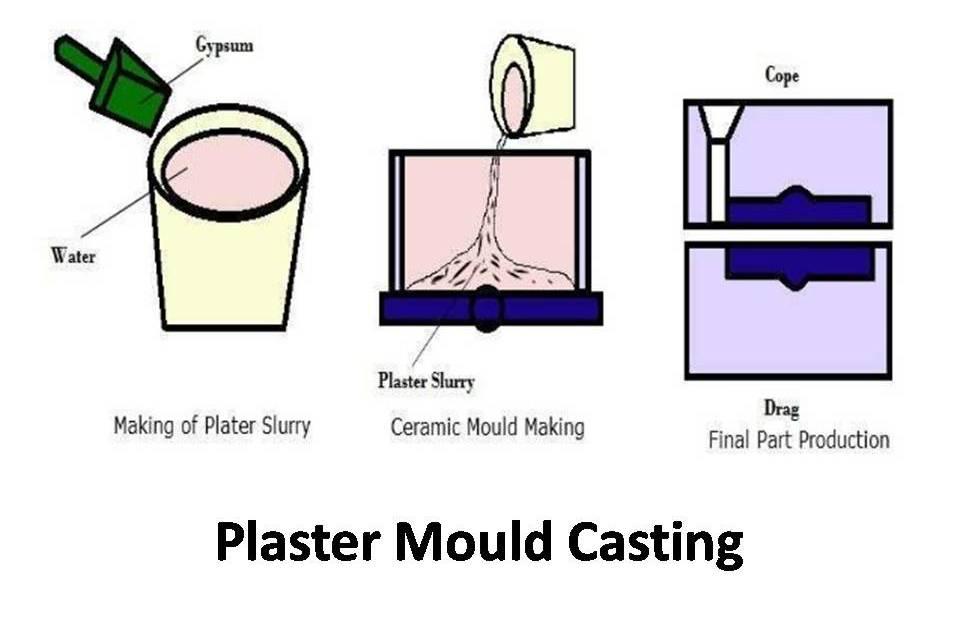
The plaster casting technique works the same as the sand casting method. However, the molding material, in this case, is the plaster of Paris and not sand.
Create a pattern from the plaster material; two or more sides of the desired shape made with a clear parting line.
Then, the plaster material is poured on the pattern to mold the shape.
Once the plaster has filled all the small features of the intended casting equipment, it can bake at higher temperatures of up 260degrees to remove any excess water.
After determining that the mold has dried well, the melted metal is poured into the hollow shape to form the casted equipment.
Allow the melted metal to dry before separating it from the casted part, and boom! You will have your Casted equipment.
The Plaster casting method applies when the equipment intended requires a clear surface finish with dimensional accuracy.
However, it is a complex process that needs a lot of monitoring to have the desired shape.
Why?
Unlike sand, plaster is not stable, and therefore many factors determine the end product of the casting equipment.
Nevertheless, the plaster absorbs a lot of water during the molding process.
Therefore, it breaks easily.
The following diagram indicates the plaster casting method.
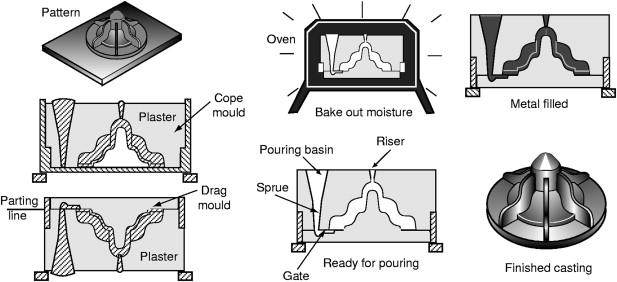
5. Low-Pressure Casting
This casting process involves melted material from a heating system rises through a tube by applying moderate pressure.
That means the melted metal does not use gravity to rise through the tube.
Usually, the location of the boiler is at the lower section of the molded shapes.
Thus with pressure adjusting, the molten metal material fills the mold shapes from the bottom and is allowed to solidify as it remains in position.
It is one of the Casting processes that require a low workforce.
Moreover, the end product is of high quality, with simple Casting equipment used. Nevertheless, the equipment used saves on the casting costs involved because the molten material is 90%-99% utilized.
The process applies in the production of the standard and high casting equipment. Others include industrial types of machinery, high volume types of equipment, traditional products like the cylinder head, hubs, and the likes.
The diagram below shows the Low-pressure casting process.
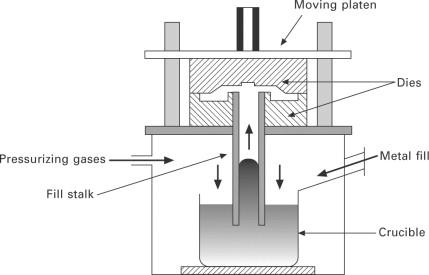
Conclusion
The casting process has undergone a lot of technological advancement.
From the ancient applications, the adaptation of the modern methods makes it appropriate in the production of complex pieces of equipment.
Moreover, the process is found helpful in the industrial, aviation, and automotive industries.
Once more, the method finds its importance in creating other ceramic pieces of equipment in our homes.
Check out our website and find out other methods used in casting processes which include the following.
- Centrifugal Casting
- Gravity Die Casting
- Vacuum Die casting
- Squeezing Die casting
- Lost foam casting
